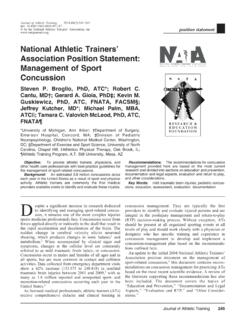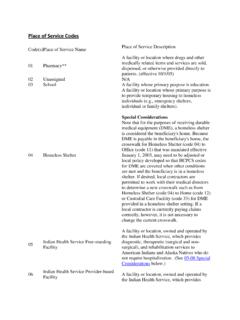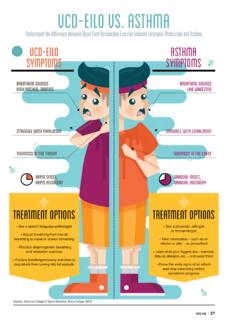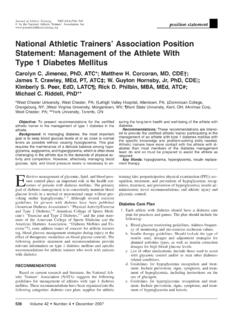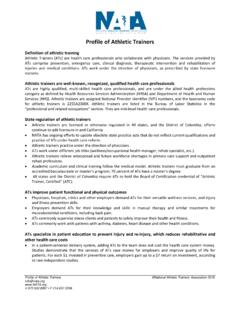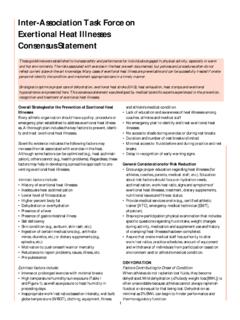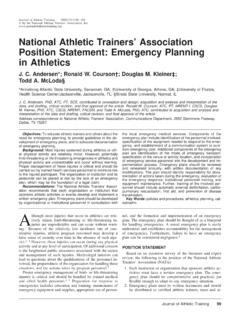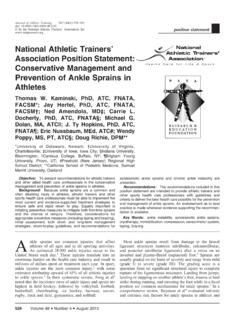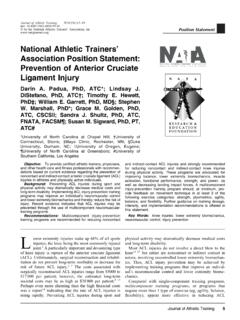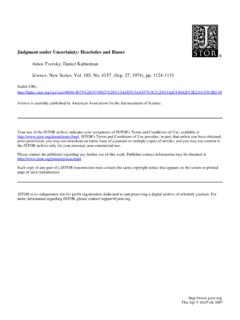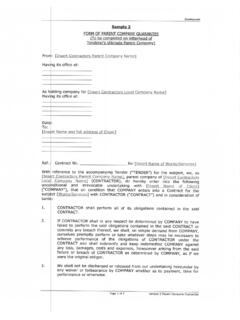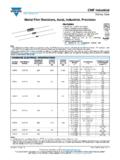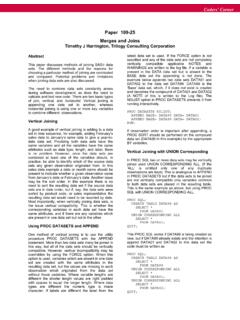Transcription of Best Practice Guidelines for Athletic Training Documentation
1 August 2017 BEST Practice Guidelines FOR Athletic Training Documentation 2 Disclaimer of Liability The materials and information provided in the National Athletic Trainers Association (NATA) Best Practice Guidelines for Athletic Training Documentation (the Guidelines ) are educational in nature, and the Guidelines are published as a resource for NATA members and is intended solely for personal use/reference in the manner described herein. NATA has taken reasonable efforts to ensure that all materials included in the Guidelines are accurate and consistent with standards of good Practice in the general Athletic trainers industry. As research and Practice advance, however, standards may change.
2 For this reason, it is recommended that NATA members evaluate the applicability of any materials included in the Guidelines in light of particular situations and changing standards. By accessing these Guidelines , NATA members agree to use it appropriately and within applicable state laws regarding Athletic Training licensure and/or regulation. In no event shall the National Athletic Trainers Association, its directors, officers, or employees be held liable for any losses, injury, damages, or any other consequences resulting from, or arising in connection with, the use or reliance on any materials provided in or accessed via the Guidelines . By accessing the Guidelines , all NATA members who make use of the Guidelines agree to indemnify, defend and hold harmless the National Athletic Trainers Association, its directors, officers, or employees, from and against any and all losses, costs, expenses, claims, damages and liabilities related to or associated with the NATA member s use of the Guidelines , including but not limited to any and all losses, costs, expenses, claims, damages and liabilities arising from or related to the improper use of the Guidelines .
3 By accessing the Guidelines , all NATA members who make use of the Guidelines agree to abide by applicable state laws, and NATA standards, rules and regulations regarding the lawful Practice of Athletic Training . 3 Preface The Board of Directors (BOD) of the National Athletic Trainers Association (NATA) formed a work group charged with developing Best Practice Guidelines for Athletic Training Documentation . The work group addressed the following areas: define all practical and appropriate Documentation practices for the Athletic trainer (AT); develop awareness of the advantages of appropriate Documentation ; identify proper methods to facilitate communication with relevant stakeholders (employers, administrators, and supervising physicians, and others); and define key terms as they pertain to Documentation .
4 The work group was comprised of ATs with various levels of experience and from diverse Athletic Training settings, including, college/university, secondary school, clinical/industrial, and education/academic. Work Group Members Chair: Charlie Thompson, MS, ATC College/University Athletic Trainers Committee Amanda Muscatell NATA Staff Liaison Patrick Buffum NATA Staff Liaison Bart Peterson, MSS, AT Secondary School Athletic Trainers Committee Larry Cooper, MS, LAT, ATC Secondary School Athletic Trainers Committee Chris Mathewson, MSS, ATC, CSCS Secondary School Athletic Trainers Committee, NATA Board of Directors Stacey Ritter, MS, ATC Secondary School Athletic Trainers Committee Michael Goldenberg, MS, ATC NATA At Large Member Elizabeth Neil, MS, LAT, ATC NATA At Large Member Terry DeZeeuw, MS, AT College/University Athletic Trainers Committee Randy Cohen, AT.
5 DPT College/University Athletic Trainers Committee Sara Nottingham, EdD, ATC Inter-Agency Terminology Workgroup Andy Gepford, MA, LAT, ATC Professional Education Committee Jeff McKibbin, MEd, LAT, ATC Governmental Affairs Committee Marty Matney, MBA, LAT, ATC Committee on Practice Advancement Gretchen Schlabach, PhD, ATC Professional Responsibility Committee Jeff Konin, PhD, ATC, PT, FACSM, FNATA Professional Responsibility Committee Outline Section I: Introduction Section II: Importance of Medical Documentation Section III: Relevant Terminology Section IV: Rules and Regulations Section V: Electronic Medical Records & Communication Section VI: Development of a Record Retention System Section VII: Setting-Specific Considerations Section VIII: References 4 Section I: Introduction Athletic Training has evolved quite rapidly over its relatively brief existence as a profession.
6 Part of this evolution includes gaining recognition and enhanced credibility as a health care discipline and validating the role of the Athletic trainer (AT) in the domain of medicine. As such, it is necessary to be held to the same standards as other medical professions as they pertain to Documentation for the purposes of patient care, communication and ethical-legal requirements. Such necessity is supported by the 7th Edition of the Board of Certification (BOC) Practice Analysis, located in Domain 5- Health Care Administration and Professional Responsibility: ATs require various criteria for Documentation of patient care and treatment, depending on setting and state requirements.
7 Using appropriate Documentation , no matter the Athletic Training setting, permits meeting of state, professional and ethical standards of Practice (p. 6).1 Documenting the services of an AT has evolved over the years. Early records were mostly hand-written, sometimes by the patients themselves, and were rudimentary at best. Many services provided by the AT were left unrecorded altogether. With the wide variety of academic and clinical mentoring styles, experiential learning and formal education, many different views exist regarding what appropriate Documentation should consist of. Questions such as what, how and when to document continue to persist, and the nuances of the variety of work-type settings unique to the profession of Athletic Training , create challenging and understandable inconsistencies.
8 Standardization of contemporary Documentation practices is essential for today s practicing AT regardless of one s employment setting. Furthermore, whether in written or electronic form, compliance to the accepted standards should be viewed as the gold standard. The primary purposes of establishing Guidelines for Documentation are four- fold. First and foremost, it is an AT s professional responsibility to comply with medical industry standards and statutory regulations of record-keeping. Second, proper Documentation serves to provide a complete, accurate and timely record of a patient s complete medical history. Third, proper recordkeeping will facilitate communication and help to ensure a consistent level of care among and within multiple care-givers across various settings.
9 Lastly, incorporating best practices for Documentation may serve to minimize the risk of malpractice for the AT and their employer in the event of litigation. This document will serve to help the AT: 1. Understand the importance of medical Documentation . 2. Recognize key terminology related to medical Documentation . 3. Understand how specific state Athletic Training Practice acts, federal laws, and associated rules and regulations guide medical Documentation . 4. Understand considerations for electronic communication and medical Documentation . 5. Recognize setting-specific variables with regard to medical Documentation . 6. Develop a record retention system in conjunction with other stakeholders for the institution.
10 5 Section II: Importance of Medical Documentation Documentation is a contemporaneous narrative detailing patient encounters and Athletic Training services provided for each and every medical situation ATs are engaged in. Accurate and up-to-date medical records facilitate better patient management and provide a precise narrative of services rendered if the clinician is required to recall events at a later date. At its core, Documentation provides a record of an initial evaluation of a condition, all treatments and interventions related to the condition, an opportunity to indicate the status of the patient as it relates to their specific condition, and a written plan detailing goals and outcomes.
